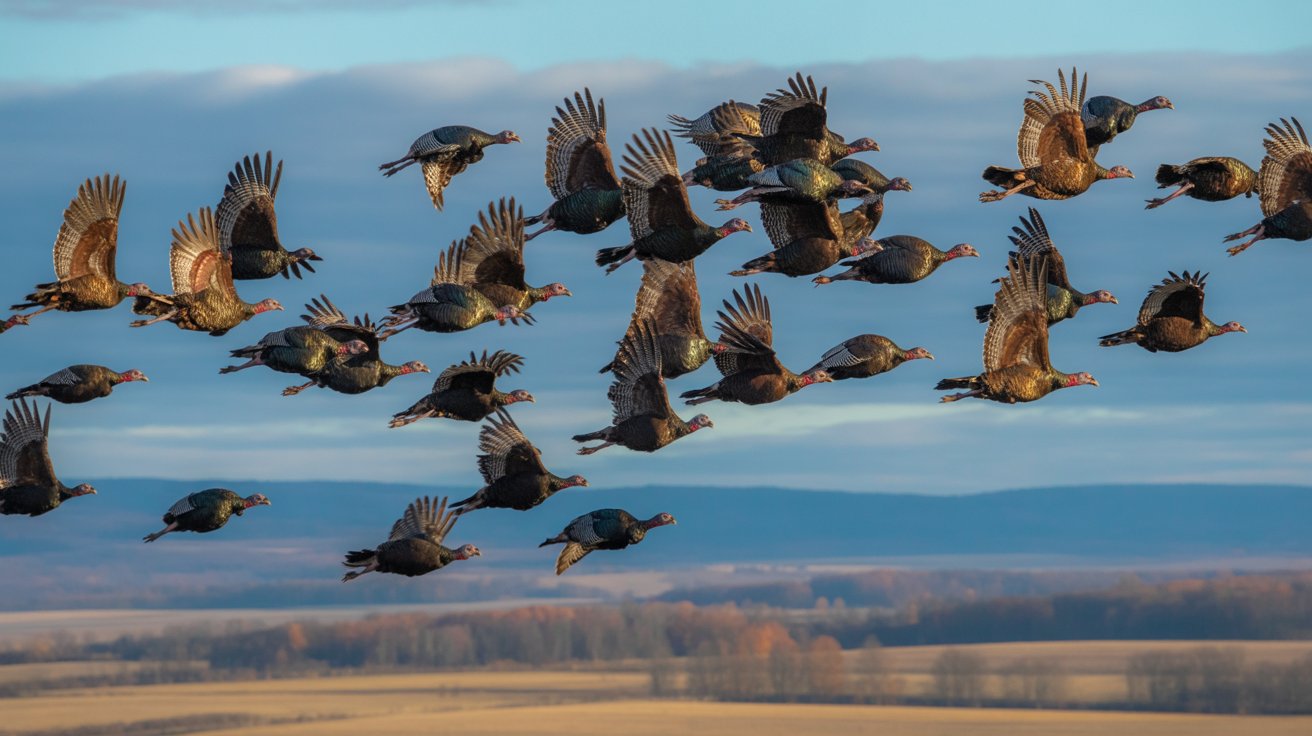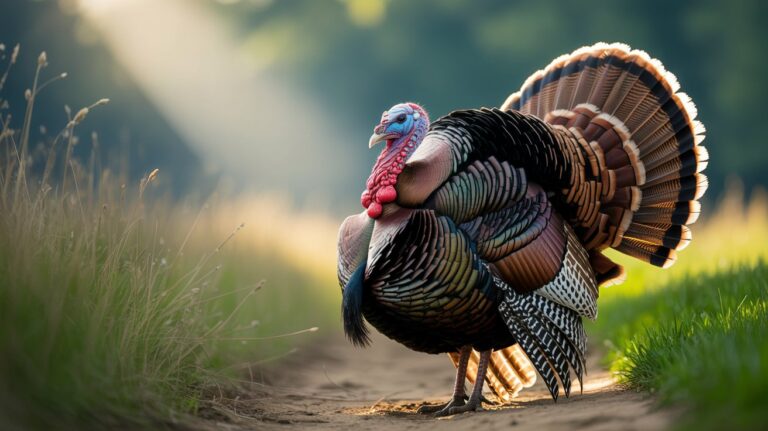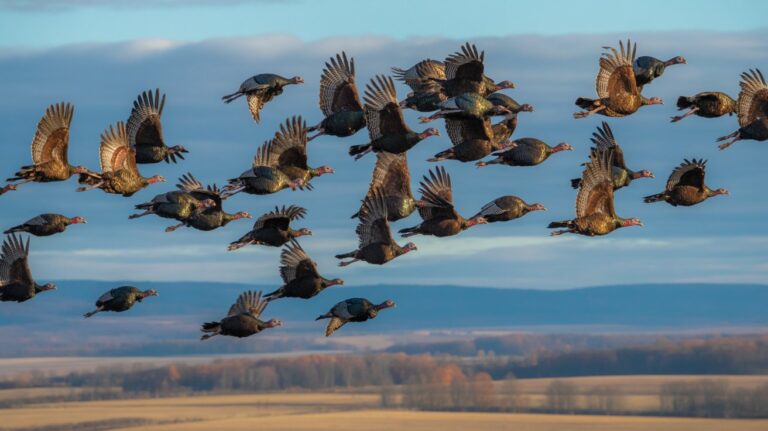Turkeys are large birds found in forests, grasslands, and farms across North America. Many people wonder, do turkeys migrate? The answer depends on the species. Wild turkeys do not migrate long distances like some birds. However, they move around within their habitat to find food and shelter, especially in winter.
On the other hand, turkey vultures do migrate. These scavenger birds travel long distances, often from North America to South America, in search of food and warmer weather. In this article, we will explore the migration habits of turkeys and turkey vultures, their seasonal movements, and how they adapt to different environments.
Wild Turkey Migration
Wild turkeys do not migrate in the same way as other birds. Instead, they move within their local range based on food availability and weather conditions. During warmer months, they roam freely in search of insects, seeds, and small plants. In winter, they gather in flocks and stay near food sources, such as farms or wooded areas.
Turkeys have strong legs and can travel several miles in a day. They prefer walking over flying and only fly short distances when escaping predators. Their ability to adapt to different environments helps them survive in changing seasons.
Do Turkey Vultures Migrate?
Unlike wild turkeys, turkey vultures are migratory birds. They travel long distances to find food and suitable living conditions. In North America, turkey vultures migrate south during winter, often reaching Central and South America.
These birds rely on warm air currents, called thermals, to glide effortlessly through the sky. By using these air currents, they save energy and travel thousands of miles without flapping their wings too much.
Do Turkeys Migrate South?
Wild turkeys do not migrate south for the winter. Instead, they stay in their home range and adapt to cold weather. When food becomes scarce, they move to areas with more food, such as farms or dense forests.
Turkeys have thick feathers that help them stay warm in freezing temperatures. They also roost in trees at night to avoid predators and harsh weather. Even in deep snow, wild turkeys can survive by scratching the ground to find food.
Turkey Vulture Seasonal Behavior
Turkey vultures change their behavior based on the seasons. During warmer months, they spread across North America, feeding on dead animals. As winter approaches, they gather in large groups and start migrating to warmer regions.
Unlike many birds, turkey vultures do not flap their wings often. They soar on rising air currents and use the wind to travel long distances. This unique flying style helps them conserve energy and complete their migration efficiently.
Wild Turkey Winter Habits
Wild turkeys have special habits that help them survive winter. They form flocks and stay in protected areas with food and shelter. Their diet changes based on what is available. Instead of insects and fresh plants, they eat acorns, nuts, and leftover crops.
To stay warm, turkeys fluff their feathers and roost in trees. They may also move to lower elevations where the weather is milder. These smart survival tactics allow them to endure harsh winters without migrating.
Turkey Vulture Migration Distance
Turkey vultures migrate long distances, sometimes traveling over 2,000 miles to reach warmer regions. Their migration distance depends on where they start and the availability of food.
Birds from northern areas travel farther, while those in warmer climates may not migrate at all. Turkey vultures rely on thermal air currents to glide effortlessly and complete their journey with minimal effort.
Do Turkeys Fly South for Winter?
No, turkeys do not fly south for the winter. They stay in their home range and adjust to seasonal changes. Unlike small migratory birds, turkeys have strong legs and prefer walking over flying.
During winter, turkeys look for food in farms, forests, and open fields. They may travel several miles in a day but remain within their natural habitat. Their thick feathers and social behavior help them survive cold temperatures.
Turkey Vulture Migration Timing
Turkey vultures begin migrating in late summer or early fall when temperatures drop and food becomes scarce. Their migration continues until winter, with some birds traveling to Mexico, Central America, or even South America.
In spring, turkey vultures return to North America to breed. They follow the same routes each year, using the sun and landscape features to navigate their way. Their migration is predictable and follows a set pattern.
Wild Turkey Seasonal Movements
Wild turkeys move according to the seasons, but they do not migrate. Their movements depend on food, weather, and safety.
- Spring and summer: Turkeys spread out in search of food, water, and nesting sites.
- Fall: They form larger flocks and prepare for winter by staying near food sources.
- Winter: Turkeys stay in forests or farmland and look for nuts, seeds, and crops.
This seasonal movement helps wild turkeys survive without the need for long-distance migration.
Turkey Vulture Migration Routes
Turkey vultures follow specific migration routes each year. They prefer flying over open landscapes, valleys, and coastlines where warm air currents help them glide.
Some of the most common migration routes include:
- North America to Central America: Birds from the northern United States and Canada fly south through Mexico.
- Eastern U.S. to South America: Some vultures travel along the East Coast before reaching South America.
- Western U.S. to Central America: Birds in the western states take a different route through the Rocky Mountains.
These routes allow vultures to travel efficiently while using as little energy as possible.
Conclusion
Turkeys and turkey vultures have different migration habits. Wild turkeys do not migrate but move within their habitat to find food and shelter. They stay in forests, farms, and open fields, adapting to seasonal changes.
Turkey vultures, on the other hand, are true migratory birds. They travel thousands of miles to escape the cold and find food. Their unique ability to soar on warm air currents makes their journey easier and more efficient.
FAQs
1. Do turkeys migrate or stay in one place?
Wild turkeys do not migrate long distances but move within their home range for food and shelter. Turkey vultures, however, migrate thousands of miles.
2. How far do turkey vultures migrate?
Turkey vultures can migrate over 2,000 miles, traveling from North America to Central or South America, depending on food availability and climate conditions.
3. Why don’t wild turkeys fly south for the winter?
Wild turkeys stay in their habitat during winter, relying on thick feathers, flocking behavior, and food sources like nuts and seeds to survive.
4. When do turkey vultures start migrating?
Turkey vultures begin migrating in late summer or early fall when temperatures drop and food becomes scarce, returning in spring to breed.
5. What are the migration routes of turkey vultures?
Turkey vultures follow set migration routes, flying along valleys, coastlines, and mountain ranges from North America to Mexico, Central America, or South America.





